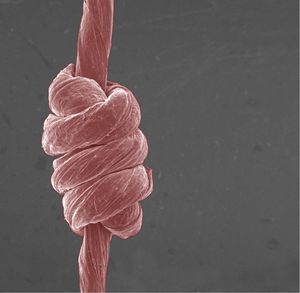Super-Stretchable Yarn Is Made of Graphene

Terrones Group/Penn State Strong, stretchable fibers made of graphene oxide can be knotted like yarn.
The researchers made a thin film of graphene oxide by chemically exfoliating graphite into graphene flakes, which were then mixed with water and concentrated by centrifugation into a thick slurry. The slurry was then spread by bar coating – something like a squeegee – across a large plate.
When the slurry dries, it becomes a large-area transparent film that can be carefully lifted off without tearing. The film is then cut into narrow strips and wound on itself with an automatic fiber scroller, resulting in a fiber that can be knotted and stretched without fracturing.
“We found this graphene oxide fiber was very strong, much better than other carbon fibers. We believe that pockets of air inside the fiber keep it from being brittle,” says Mauricio Terrones, professor of physics, chemistry and materials science and engineering at Penn State.
Terrones and colleagues believe this method opens up multiple possibilities for useful products. For instance, removing oxygen from the GO fiber results in a graphene fiber with high electrical conductivity.
Adding silver nanorods to the graphene film would increase the conductivity to the same as copper, which could make it a much lighter weight replacement for copper transmission lines. Many kinds of highly sensitive sensors are imaginable.
“The importance is that we can do almost any material, and that could open up many avenues – it’s a lightweight material with multifunctional properties,” Terrones remarks.
And the main ingredient, graphite, is mined and sold by the ton.
Their discovery was reported online in a recent issue of ACS Nano and titled “Super-stretchable Graphene Oxide Macroscopic Fibers with Outstanding Knotability Fabricated by Dry Film Scrolling.” (ACS Nano 2014, DOI: 10.1021/nn501098d) Penn State and Shinshu University have applied for a joint patent on the process.
The researchers received support from the Research Center for Exotic Nanocarbons, Japan, and the Center for Nanoscale Science, Penn State. Contact Mauricio Terrones at mutt11@psu.edu.
Media Contact
More Information:
http://www.psu.eduAll latest news from the category: Materials Sciences
Materials management deals with the research, development, manufacturing and processing of raw and industrial materials. Key aspects here are biological and medical issues, which play an increasingly important role in this field.
innovations-report offers in-depth articles related to the development and application of materials and the structure and properties of new materials.
Newest articles

A universal framework for spatial biology
SpatialData is a freely accessible tool to unify and integrate data from different omics technologies accounting for spatial information, which can provide holistic insights into health and disease. Biological processes…

How complex biological processes arise
A $20 million grant from the U.S. National Science Foundation (NSF) will support the establishment and operation of the National Synthesis Center for Emergence in the Molecular and Cellular Sciences (NCEMS) at…

Airborne single-photon lidar system achieves high-resolution 3D imaging
Compact, low-power system opens doors for photon-efficient drone and satellite-based environmental monitoring and mapping. Researchers have developed a compact and lightweight single-photon airborne lidar system that can acquire high-resolution 3D…





















